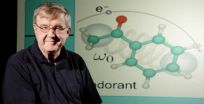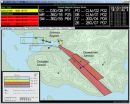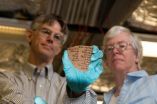(Press-News.org) New cancer drugs must be thoroughly tested in preclinical models, often in mice, before they can be offered to cancer patients for the first time in phase I clinical trials. Key components of this process include pharmacokinetic and pharmacodynamic studies, which evaluate how the drug acts on a living organism. These studies measure the pharmacologic response and the duration and magnitude of response observed relative to the concentration of the drug at an active site in the organism.
A new comparison of four different methodologies for pharmacokinetic and pharmacodynamic testing of the anti-melanoma agent carboplatin, demonstrates that genetically-engineered mouse models provide tumor delivery of drug most comparable to the response seen in melanoma patients.
"These studies are critically important in the case of small-molecule cancer drugs, which often have systemic side effects and can be toxic at high concentrations," said Ned Sharpless, MD, Wellcome Distinguished Professor of Cancer Research and study co-author.
The study, led by Bill Zamboni, PharmD and PhD, Associate Professor of Pharmacotherapy and Experimental Therapeutics at the UNC Eshelman School of Pharmacy and a member of UNC Lineberger Comprehensive Cancer Center, and Ned Sharpless, MD, who is also Associate Director for Translational Research at UNC Lineberger.
The collaborative study, which appears in The Oncologist, brought together a set of unique resources available at UNC to determine which preclinical models best predict delivery of carboplatin to melanoma tumors in patients. "We have a unique opportunity to evaluate an important factor in the treatment of solid tumors because of the outstanding collaborative nature and novel resources at UNC", said Zamboni.
"We have used a pharmacokinetics testing method called microdialysis, which uses a tiny probe to take samples that measure serial drug concentrations in a tumor over time," he added.
"We plan to use this method to advance pharmacology studies of anticancer agents in tumors and tissues of patients and to evaluate the tumor delivery of nanoparticles and other classes of delivery agents."
The team used the resources of the preclinical phase I unit at UNC Lineberger to compare how pharmacokenetic levels vary in several preclinical tumor models including a genetically-engineered model, a model where tumor cells are transplanted to the appropriate part of the body (called an orthotopic syngeneic transplant or OST), and a xenograft model, where human tumor tissue is transplanted.
"Because carboplatin is widely used, we have good data on how the drug works pharmacokenetically in humans. For the first time, we were able to compare these various laboratory techniques used in countless labs and the pharmaceutical industry to evaluate how carboplatin was delivered to the tumor and compare it to actual human data. None of these laboratory models are perfect, but the genetically-engineered model is the best in terms of predicting the amount of drug that is delivered to the tumor in human patients," Zamboni added.
"We know that laboratory models are imperfectly predictive of human response and if the
tumor models don't predict delivery, they are most likely not an optimal research tools," he noted.
Sharpless added, "We are continually looking for ways to build better laboratory models so that new therapies move from the lab to the patient as quickly and safely as possible. This study provides valuable validation that genetically-engineered models can help us accomplish this objective."
###
Other members of the research team include Austin Combest, PharmD, MBA, Katie Sandison, BS, Suzan Hanna, MS, of UNC Eshelman School of Pharmacy, UNC Lineberger researchers Patric Roberts, PhD, PharmD, Patric Dillon, MD, and Charlene Ross, Beth Zamboni, MS, of Carlow University (Pittsburgh, PA), Sohrab Habibi, PhD, of the UNC Department of Chemistry and Markus Muller, MD, and Martin Brunner, MD, of Vienna University Hospital (Austria).
The research received support by the UNC Lineberger Comprehensive Cancer Center Mouse Phase I Unit, grants from Golfers Against Cancer, the National Institutes of Health (ES014635 and CA141576), the UNC Lineberger University Cancer Research Fund and the American Cancer Society.
Genetically-engineered preclinical models predict pharmacodynamic response
Preclinical testing a necessary step in drug development
2012-09-19
ELSE PRESS RELEASES FROM THIS DATE:
Can post-breakup Facebook surveillance delay emotional recovery?
2012-09-19
New Rochelle, NY, September 19, 2012—More than 900 million people worldwide are active users of the social networking site Facebook, and it is estimated that as many as one-third report using Facebook to check on the activities of former romantic partners. The effects of remaining Facebook friends with an ex-lover or even just following their activities online can disrupt a person's ability to heal emotionally and move on with his or her life, according to an article in Cyberpsychology, Behavior, and Social Networking, a peer-reviewed journal published by Mary Ann Liebert ...
Odorant shape and vibration likely lead to olfaction satisfaction
2012-09-19
CHAMPAIGN, Ill. — A new study of the sense of smell lends support to a controversial theory of olfaction: Our noses can distinguish both the shape and the vibrational characteristics of odorant molecules.
The study, in the journal Physical Chemistry Chemical Physics, demonstrates the feasibility of the theory – first proposed decades ago – that the vibration of an odorant molecule's chemical bonds – the wagging, stretching and rocking of the links between atoms – contributes to our ability to distinguish one smelly thing from another.
"The theory goes that when the ...
New airport system facilitates smoother take-offs and landings
2012-09-19
Contact: David Hosansky
303-497-8611
hosansky@ucar.edu
NCAR/UCAR
Zhenya Gallon, NCAR/UCAR Media Relations
303-497-8607
zhenya@ucar.edu
New airport system facilitates smoother take-offs and landings
BOULDER--For airline passengers who dread bumpy rides to mountainous destinations, help may be on the way. A new turbulence avoidance system has for the first time been approved for use at a U.S. airport and can be adapted for additional airports in rugged settings across the United States and overseas.
The system, developed by the National Center for Atmospheric ...
GEOLOGY adds 30 new articles online
2012-09-19
Boulder, Colo., USA – This month, GSA's top geoscience journal, Geology, has posted 30 new articles ahead of print. Locations studied include Bhutan; the James Bay Lowland of Canada; Mount Taranaki, New Zealand; Fort Stanton Cave and Carlsbad Cavern, New Mexico, USA; the Quelccaya Ice Cap, Peru; the Nile Delta; and Mars. Topics include methane hydrates, microbial micro-tunneling, fibrous diamonds, climate change, cosmic rays, and maars. Also in Geology: the first application of CARS microscopy to the geosciences.
Highlights are provided below. GEOLOGY articles published ...
Joint UT study: Reading food labels helps shoppers stay thinner
2012-09-19
KNOXVILLE—Shoppers — particularly women — who take the time to read food labels are thinner than those who don't.
These findings are from a recently released study authored by Steven T. Yen, a University of Tennessee professor in the Institute of Agriculture's Department of Agricultural and Resource Economics, in conjunction with researchers at the University of Santiago de Compostela in Spain, the University of Arkansas and the Norwegian Institute for Agricultural Finance Research.
Women who read food labels weighed nearly 9 pounds less than women who didn't read labels, ...
Surprising demographic shifts in endangered monkey population challenge conservation expectations
2012-09-19
MADISON – At first glance, the northern muriqui monkey is a prime conservation success story.
These Brazilian primates are critically endangered, but in the past 30 years a population on a private reserve has grown from just 60 individuals to some 300, now comprising almost a third of the total remaining animals.
As the population grows, though, it is offering researchers a glimpse into a new phase of recovery as it begins to face the limitations of its habitat. A recent analysis of the factors contributing to this population's tremendous growth reveals surprising trends ...
New tools help nursing homes track and prevent deadly infections
2012-09-19
CHICAGO (September 18, 2012) – The Society for Healthcare Epidemiology of America (SHEA) and Centers for Disease Control and Prevention (CDC) have each released new tools and information to help track deadly healthcare-associated infections (HAIs) in nursing homes and other long-term care settings. Potentially deadly HAIs strike volumes of nursing home residents each year, with best estimates suggesting that up to 2.8 million infections can occur in this population annually.
Published online this week in Infection Control and Hospital Epidemiology, the journal of SHEA, ...
Economic freedom report: US continues slide, drops to 18th
2012-09-19
TALLAHASSEE, Fla. ⎯ The United States, long considered a champion of economic freedom, plunged to No. 18 in new rankings published in the 2012 Economic Freedom of the World, an annual report co-authored by Florida State University economics Professor James Gwartney.
The report is published by Canada's Fraser Institute in cooperation with institutes in 78 other nations and territories. The U.S. publisher is the Cato Institute. The 2012 report, released on Sept. 18, uses 42 different variables derived from sources such as the World Bank and International Monetary ...
Dictionary completed on language used everyday in ancient Egypt
2012-09-19
A dictionary of thousands of words chronicling the everyday lives of people in ancient Egypt — including what taxes they paid, what they expected in a marriage and how much work they had to do for the government — has been completed by scholars at the University of Chicago.
The ancient language is Demotic Egyptian, a name given by the Greeks to denote it was the tongue of the demos, or common people. It was written as a flowing script and was used in Egypt from about 500 B.C. to 500 A.D., when the land was occupied and usually dominated by foreigners, including Persians, ...
Funding for medical research and science programs faces draconian cuts
2012-09-19
Bethesda, MD – A new report from the Office of Management and Budget (OMB) is a stark reminder of the perilous situation facing the medical research and scientific communities unless Congress and the President take action to prevent the pending sequestration. Set in motion by the Budget Control Act of 2011, sequestration would impose automatic cuts on federal funding starting on January 2, 2013. According to OMB, the budget for the National Institutes of Health (NIH) would be reduced by $2.529 billion, the National Science Foundation would lose $586 million, and the Department ...
LAST 30 PRESS RELEASES:
First Editorial of 2026: Resisting AI slop
Joint ground- and space-based observations reveal Saturn-mass rogue planet
Inheritable genetic variant offers protection against blood cancer risk and progression
Pigs settled Pacific islands alongside early human voyagers
A Coral reef’s daily pulse reshapes microbes in surrounding waters
EAST Tokamak experiments exceed plasma density limit, offering new approach to fusion ignition
Groundbreaking discovery reveals Africa’s oldest cremation pyre and complex ritual practices
First breathing ‘lung-on-chip’ developed using genetically identical cells
How people moved pigs across the Pacific
Interaction of climate change and human activity and its impact on plant diversity in Qinghai-Tibet plateau
From addressing uncertainty to national strategy: an interpretation of Professor Lim Siong Guan’s views
Clinical trials on AI language model use in digestive healthcare
Scientists improve robotic visual–inertial trajectory localization accuracy using cross-modal interaction and selection techniques
Correlation between cancer cachexia and immune-related adverse events in HCC
Human adipose tissue: a new source for functional organoids
Metro lines double as freight highways during off-peak hours, Beijing study shows
Biomedical functions and applications of nanomaterials in tumor diagnosis and treatment: perspectives from ophthalmic oncology
3D imaging unveils how passivation improves perovskite solar cell performance
Enriching framework Al sites in 8-membered rings of Cu-SSZ-39 zeolite to enhance low-temperature ammonia selective catalytic reduction performance
AI-powered RNA drug development: a new frontier in therapeutics
Decoupling the HOR enhancement on PtRu: Dynamically matching interfacial water to reaction coordinates
Sulfur isn’t poisonous when it synergistically acts with phosphine in olefins hydroformylation
URI researchers uncover molecular mechanisms behind speciation in corals
Chitin based carbon aerogel offers a cleaner way to store thermal energy
Tracing hidden sources of nitrate pollution in rapidly changing rural urban landscapes
Viruses on plastic pollution may quietly accelerate the spread of antibiotic resistance
Three UH Rainbow Babies & Children’s faculty elected to prestigious American Pediatric Society
Tunnel resilience models unveiled to aid post-earthquake recovery
Satellite communication systems: the future of 5G/6G connectivity
Space computing power networks: a new frontier for satellite technologies
[Press-News.org] Genetically-engineered preclinical models predict pharmacodynamic responsePreclinical testing a necessary step in drug development




